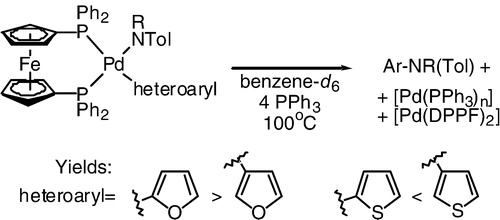Understanding the Coupling of Heteroaromatic Substrates: Synthesis, Structures, and Reductive Eliminations of Heteroarylpalladium Amido Complexes

Palladium furyl- and thiophenyl complexes have been studied to uncover the origin of the difference in reactivity between coupling of five-membered heterocyclic halides and coupling of aryl halides and six-membered heteroaryl halides. A range of DPPF-ligated furanylpalladium and thiophenylpalladium halide and amido complexes were synthesized, and several examples were structurally characterized. The heteroatom in the 2-heteroaryl groups did not coordinate palladium to generate η2-heteroaryl complexes. The furyl- and thiophenylpalladium complexes underwent reductive elimination of heteroarylamines in yields that were much different for related 2- and 3-isomers. The yields of reductive elimination from these isomeric complexes paralleled the yields from catalytic aminations of 2- and 3-halofurans and 2- and 3-halothiophenes. This correlation suggests that the scope of the amination of five-membered heteroaryl halides is controlled by the reductive elimination step. The yields of reductive elimination correlated with the distribution of electron density at different positions of furans and thiophenes, and this correlation between electron density at different positions of the heteroarenes explains why yields are higher for reductive elimination from 2-furyl and 3-thiophenyl complexes than they are from 3-furyl and 2-thiophenyl complexes.
Read more on publisher's site.